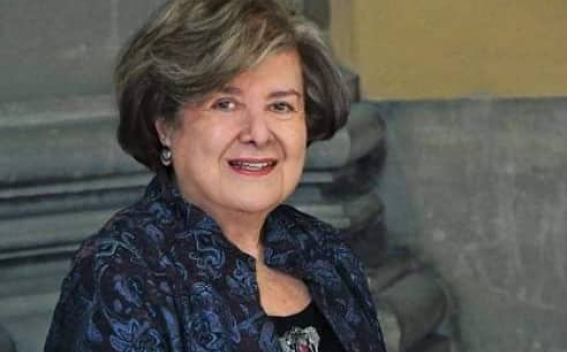Anna Kazanjian Longobardo, Armenian, Designer of the American Missile Navigation System

Anna Kazanjian Longobardo, designer of “Saturn” missile navigation system, “Viking” space project, “Avangard” transmission system, former director of the engineering firm Woodward Clyde Group and executive at Unisys Corp.
In 1949 Anna Longobardo became the first woman to receive a B.S. in mechanical engineering from Columbia University, she was one of the founders of the Society of Women Engineers, which elected her a fellow, the first woman to receive the Egleston Medal for distinguished engineering achievements, and she was listed as one of New York's "100 Women of Influence."
Anna Kazanjian was born in New York, in 1928, to the family of Armenian migrants. Passion for science was demonstrated at an early age. Her father was an Armenian immigrant from Aleppo, and her mother from Constantinople. The family had undergone the Armenian Genocide and reached the US after WW1. Her mother’s maiden name is Yazejian, her great uncle was well known teacher and leader Hayk Khojasarian.
With her doctoral degree from Colombia university in 1952, Anna became the first female scientist in mechanical engineering. “We, the women, should work on our self-esteem and not allow faliures,” she said in an interview.
Longobardo was one of the first women in the United States to work on board navy submarines, destroyers and other vessels. She designed and evaluated submarine-towed buoy used to calibrate sonar. Her design increased navigational accuracy for submarines that operate below periscope depth.
In 1956 when they accept her as a leading specialist in "Sperry RAND", she gets engaged in the development of analog and digital programs.
In those years she made a great contribution to the development of navigational systems in the aviation industry, in particular, participated in the creation of the “Saturn” missile and the “Viking” space system as well as the “Avangard” project.
The “Avangard” project intended to send the first American satellite into the orbit, however, the rocket blew off upon launch. After the unsuccessful launch “Sperry RAND” rejected civilian orders and went on to produce military products.
Anna began to work on calculating the flight of “Atlas” type ballistic systems designed for the Pentagon. 1957 Anna Kazanjian developed specific guidelines that allowed to hit the target at 10,000 miles. Her calculations were included in a super-confidential collection, which was accessible only to the country's top officials. Two years later, NASA was finally able to use these calculations to launch several satellites.
These achievements made Anna Kazanjian chief of Exploration and Development of Military Engineering Systems. Later she became head of “Woodward Clyde Group” engineering company and executive director of “Unisys Corp”.
“We can do more if we want. The important thing is that we strive to do something. There is nothing impossible,” Kazanjian said.
Until 1965 before becoming head of the Division for Exploration and Development of Military Engineering Systems, Kazanjian was not only engaged in the creation of systems, but also personally participated in test flights.
Anna is one of the founders of the Society of Women Engineers.
In 1966-1970 she was the director of the New York Technical Enterprises Council. Kazanjian is still a fellow of Barnard College Mechanical Engineering Council. She currently lives in Bronxville, New York.
Other materials on this subject
- Alenush Teryan: Iran’s First Female Astronomer and Founder of First Solar Observatory “My daughter’s name is sun, my son’s name is moon”, would say Iran’s first astronomer and founder of the first solar observatory Alenush Teryan.
- Armenian Hakob Martayan - the Founder of the Modern Turkish Language When Kemal Ataturk decided to implement a reform of the Turkish language and translate the Ottoman-Turkish language (Osmanli) from Arabian into the Latin alphabet, he requested Hakob Martayan to do the...
- Asatour Sarafian, the Inventor of Automatic Transmission For Automobiles Asatour Sarafian, was an Armenian American inventor who patented a number of works, including an automatic transmission for automobiles, the needleless inoculation gun, the primary controls of the first...
- Alexander Leonovich Kemurdzhian, Designer of the First Planet Rover The mission of Kemurdzhian’s life was the design of space technology and participation in the design of the world's first automatic self-propelled apparatus for research on the lunar surface.
- Armenian Anita Caracotchian: The First Female Oceanographer in the World “A part of my people lived at the sea for 300 years, we had glorious Cilicia, that harbored more than one thousand Armenian ships having tight commercial ties with the most powerful countries. After...
-
 17:08
17:08The regular session of the Anti-corruption Policy Council takes place in Jermuk
-
 15:05
15:05The Prime Minister sends congratulatory messages to the supreme leader of Iran and the President of Iran
-
 11:11
11:11Armenia sends earthquake aid to Turkey
-
 10:43
10:43Commemoration of the Pontiff St. Sahak Partev
-
 09:16
09:16Some roads are closed and difficult to pass in Armenia
-
 19:55
19:55Phone conversation of the Foreign Minister of Armenia with the U.S. Assistant Secretary of State for European and Eurasian Affairs
-
 18:30
18:30Prime Minister Pashinyan and President Khachaturyan meet
-
 18:20
18:20Ararat Mirzoyan with Co-Chairman of the OSCE Minsk Group of France Brice Roquefeuil
-
 17:01
17:01Humans could land on Mars within 10 years, Musk predicts
-
 16:45
16:45France, US urge 'immediate' end to Nagorno Karabakh blockade
-
 16:01
16:01Blockaded Nagorno Karabakh launches fundraiser to support quake-hit Syria
-
 15:59
15:59Earthquake death toll in Turkey rises to 18,342
-
 15:43
15:43Ararat Mirzoyan Held a Telephone Conversation with Sergey Lavrov
-
 15:06
15:06French president rules out fighter jet supplies to Ukraine in near future
-
 14:47
14:475 Day Weather Forecast in Armenia
-
 14:44
14:44President Vahagn Khachaturyan wrote a note in the book of condolences opened in the Embassy of Syria in Armenia
-
 14:20
14:20Azerbaijan’s provocations impede establishment of peace and stability – Armenian FM tells Russian Co-Chair of OSCE MG
-
 12:57
12:57France representation to OSCE: Paris calls on Azerbaijan to restore freedom of movement through Lachin corridor
-
 11:40
11:40Command of Kosovo forces highly appreciated preparation of Armenian peacekeepers
-
 10:16
10:16The United States withdrew from sanctions against Syria for six months the provision of assistance after the earthquake
day
week
month
Humidity: %
Wind: km/h









